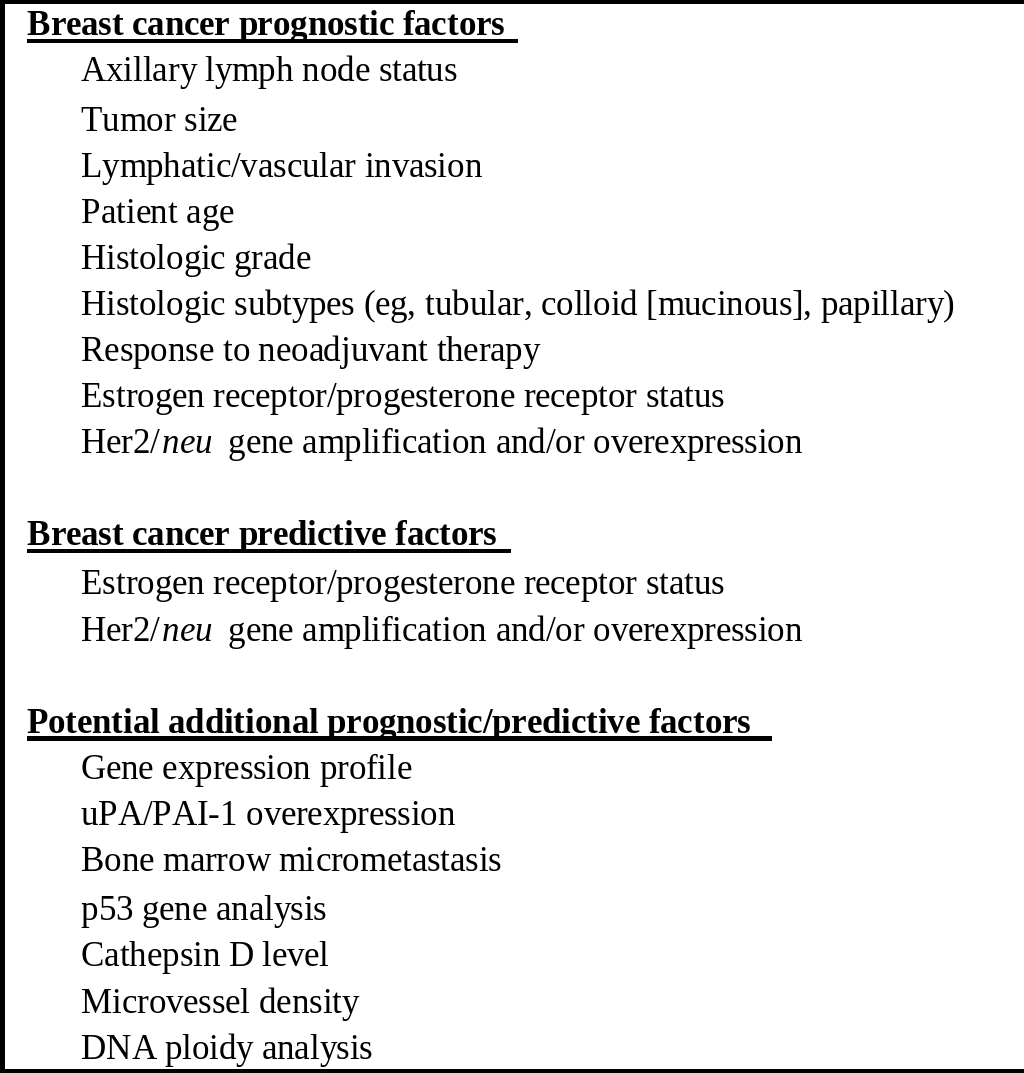PROGNOSTIC AND PREDICTIVE FACTORS IN BREAST CANCER KYLE T
APPENDIX 2 COMPARISON OF PROGNOSTIC SEARCH STRINGS (A) PERFORMANCEPROGNOSTIC AND PREDICTIVE FACTORS IN BREAST CANCER KYLE T
PROGNOSTIC DISCUSSION FOR LONGLEAD SEASONAL OUTLOOKS NWS CLIMATE PREDICTION
THE PROGNOSTIC VALUE OF DIPSTICK URINALYSIS IN CHILDREN ADMITTED
Breast cancer is the most common malignant tumor in American women, and is second to only lung cancer in mortality

Prognostic and Predictive Factors in Breast Cancer
Kyle T. Bradley, MD, MS
CAP Cancer Committee
Breast cancer is the most common malignant tumor in American women and is second only to lung cancer as a cause of cancer-related mortality.1 During the past two decades the mortality rate has declined significantly, primarily due to the early use of adjuvant systemic therapy as well as detection of earlier stage tumors due to increased screening.1,2 The mainstay of treatment for patients with localized disease is surgical excision and staging axillary lymph node evaluation with or without radiation therapy. Some patients receive neoadjuvant chemotherapy or hormonal therapy prior to definitive excision of the tumor. Other treatment options include adjuvant chemotherapy, hormonal therapy or monoclonal antibody therapy with a primary goal of eliminating or delaying the subsequent appearance of clinically occult micrometastases.
P rognostic
and predictive factors are universally utilized in the management of
breast cancer and can be used to stratify patients into two groups:
(1) those who are expected to derive the most benefit from adjuvant
systemic therapy, which includes all patients with lymph node
metastases and a subset of node-negative patients, and (2) those for
which the risks and costs of adjuvant therapy outweigh the expected
benefit.3
In this context, prognostic factors should be distinguished from
predictive factors. A prognostic factor may be defined as a
measurable variable that correlates with the natural history of the
disease. In contrast, a predictive factor is one that is associated
with response to a given therapy. Some factors, such as estrogen
receptor/progesterone receptor (ER/PR) status and HER2/neu
gene amplification and/or overexpression, are both prognostic and
predictive.
rognostic
and predictive factors are universally utilized in the management of
breast cancer and can be used to stratify patients into two groups:
(1) those who are expected to derive the most benefit from adjuvant
systemic therapy, which includes all patients with lymph node
metastases and a subset of node-negative patients, and (2) those for
which the risks and costs of adjuvant therapy outweigh the expected
benefit.3
In this context, prognostic factors should be distinguished from
predictive factors. A prognostic factor may be defined as a
measurable variable that correlates with the natural history of the
disease. In contrast, a predictive factor is one that is associated
with response to a given therapy. Some factors, such as estrogen
receptor/progesterone receptor (ER/PR) status and HER2/neu
gene amplification and/or overexpression, are both prognostic and
predictive.
The most significant prognostic factor in breast cancer is the presence or absence of axillary lymph node involvement,4 which is usually assessed at the time of surgery using sentinel lymph node biopsy or axillary dissection. Macrometastases (>0.2 cm in size) have clearly been shown to have prognostic significance. Smaller metastases (i.e., micrometastases and isolated tumor cells) have not been shown to have prognostic significance when the initial processing of lymph nodes has been controlled and all macrometastases detected. The value of serial sections and/or immunohistochemistry to detect these small metastases remains under investigation.
The vast majority of patients found to have lymph node metastases are candidates for adjuvant systemic therapy. However, determining which node-negative patients should receive adjuvant therapy is challenging, particularly because the majority are cured by surgical excision alone. The benefit to those patients who are destined to relapse is minimal, and the costs and toxicities of the treatments are significant. Thus, node-negative patients require further stratification using additional prognostic and predictive factors.
Tumor size has long been recognized as an independent prognostic factor and as a predictor of axillary node status, with larger tumors being associated with a worse prognosis and an increased likelihood of nodal metastasis.4 Additional established prognostic factors include lymphatic/vascular invasion, patient age and histologic grade of the tumor. Certain histologic subtypes of breast cancer are generally associated with a favorable prognosis, including tubular, colloid (mucinous) and papillary carcinoma. The proliferation rate of the tumor as determined by the mitotic count is also of prognostic importance, but this information is included as a component of the tumor grade. Other methods for determining tumor proliferation (e.g., thymidine labeling index, Ki-67 immunostaining or determination of the S-phase fraction by flow cytometry) likely do not add additional prognostic information. Response to neoadjuvant chemotherapy and hormonal therapy has been shown to be a strong prognostic factor, and has the added benefit of providing a short-term endpoint for the rapid evaluation of treatment protocols.5-7 Determining patient response to neoadjuvant therapy is best achieved using pathologic evaluation of the post-treatment specimen. Multiple scoring systems have been devised to evaluate tumor response.
Factors that may have prognostic impact but are not routinely used in clinical practice include overexpression of urokinase plasminogen activator (uPA) and its inhibitor PAI-1,8 detection of bone marrow micrometastases at the time of diagnosis,9 p53 gene analysis, markers of invasion (e.g., levels of the proteolytic enzyme cathepsin D), markers of angiogenesis (e.g., microvessel density as detected by immunohistochemistry) and DNA ploidy analysis.3,10 Another newly identified potential prognostic factor is the tumor gene expression profile. Molecular assays have been developed to analyze patterns of gene expression by individual tumors, and this has been shown to be useful both as a predictor of response to chemotherapy and as a prognostic factor for clinical outcome, particularly in patients with early stage, node-negative disease.11,12
All cases of invasive breast carcinoma are evaluated for ER/PR status using immunohistochemistry, which has both predictive and prognostic value. The presence of hormone receptors is a powerful predictive factor for the likelihood of benefit from adjuvant hormonal therapy including aromatase inhibitors (e.g., anastrozole, letrozole) and tamoxifen, an oral selective estrogen receptor modulator.13-15 As a prognostic factor, ER and/or PR positivity is associated with reduced mortality compared to women with ER and/or PR negative disease.16 However, the percentage of immunohistochemically positive tumor cells used to classify a tumor as ER or PR positive varies among institutions. Studies support that carcinomas with >1% ER positive cells have better survival rates compared to carcinomas that are completely devoid of ER.17,18
The HER2/neu (ERBB2) oncogene is amplified and/or overexpressed in approximately 20% of breast cancers, and is a strong prognostic factor for relapse and poor overall survival, particularly in node-positive patients.19,20 Amplification and/or overexpression of the HER2/neu gene is routinely evaluated, using immunohistochemistry and/or fluorescence in-situ hybridization (FISH), in all cases of invasive breast carcinoma, although variability in testing remains a major issue with both methodologies. The American Society of Clinical Oncology (ASCO) and the College of American Pathologists (CAP) recently published a clinical practice guideline on improving the accuracy of HER2 testing for breast cancer patients.21 As a predictive factor, HER2/neu status strongly predicts response to treatment with the anti-HER2 monoclonal antibody trastuzumab,22 and may be predictive of resistance to alkylator-based chemotherapy, the need for higher dose chemotherapy, benefit from adjuvant anthracyclines and tamoxifen resistance.3
In summary, several well-established prognostic and predictive factors are universally used to guide the clinical management of women with breast cancer. Despite the success of these markers, difficulties remain in accurately identifying those patients who are best suited for adjuvant systemic therapy, particularly among women with early stage disease. Numerous additional factors are currently under investigation, and some show great promise in improving our ability to predict patient prognosis and response to therapy.
Acknowledgement:
I would like to thank Susan C. Lester, MD, PhD, for reviewing this article and providing excellent suggestions for improvement.
References
Jemal A, Siegel R, Ward E, et al. Cancer statistics, 2007. CA Cancer J Clin. 2007;57(1):43–66.
Jatoi I, Miller AB. Why is breast-cancer mortality declining? Lancet Oncol. 2003;4(4):251–4.
Cianfrocca M, Goldstein LJ. Prognostic and predictive factors in early-stage breast cancer. Oncologist. 2004;9(6):606–16.
Carter CL, Allen C, Henson DE. Relation of tumor size, lymph node status, and survival in 24,740 breast cancer cases. Cancer. 1989;63(1):181–7.
Carey LA, Metzger R, Dees EC, et al. American Joint Committee on Cancer tumor-node-metastasis stage after neoadjuvant chemotherapy and breast cancer outcome. J Natl Cancer Inst. 2005;97(15):1137–42.
Abrial SC, Penault-Llorca F, Delva R, et al. High prognostic significance of residual disease after neoadjuvant chemotherapy: a retrospective study in 710 patients with operable breast cancer. Breast Cancer Res Treat. 2005;94(3):255–63.
Ogston KN, Miller ID, Payne S, et al. A new histological grading system to assess response of breast cancers to primary chemotherapy: prognostic significance and survival. Breast. 2003;12(5):320–7.
Look M, van Putten W, Duffy M, et al. Pooled analysis of prognostic impact of uPA and PAI-1 in breast cancer patients. Thromb Haemost. 2003;90(3):538–48.
Braun S, Vogl FD, Naume B, et al. A pooled analysis of bone marrow micrometastasis in breast cancer. N Engl J Med. 2005;353(8):793–802.
Masood S. Prognostic/predictive factors in breast cancer. Clin Lab Med. 2005;25(4):809–25, viii.
Paik S, Shak S, Tang G, et al. A multigene assay to predict recurrence of tamoxifen-treated, node-negative breast cancer. N Engl J Med. 2004; 351(27):2817–26.
van 't Veer LJ, Dai H, van de Vijver MJ, et al. Gene expression profiling predicts clinical outcome of breast cancer. Nature. 2002;415(6871):530–6.
Fisher B, Jeong JH, Bryant J, et al. Treatment of lymph-node-negative, oestrogen-receptor-positive breast cancer: long-term findings from National Surgical Adjuvant Breast and Bowel Project randomised clinical trials. Lancet. 2004;364(9437):858–68.
Winer EP, Hudis C, Burstein HJ, et al. American Society of Clinical Oncology technology assessment on the use of aromatase inhibitors as adjuvant therapy for postmenopausal women with hormone receptor-positive breast cancer: status report, 2004. J Clin Oncol. 2005;23(3):619–29.
Tamoxifen for early breast cancer: an overview of the randomised trials. Early Breast Cancer Trialists' Collaborative Group. Lancet. 1998;351(9114):1451–67.
Fisher B, Redmond C, Fisher ER, Caplan R. Relative worth of estrogen or progesterone receptor and pathologic characteristics of differentiation as indicators of prognosis in node negative breast cancer patients: findings from National Surgical Adjuvant Breast and Bowel Project Protocol B-06. J Clin Oncol. 1988;6(7):1076–87.
Cheang MC, Treaba DO, Speers CH, et al. Immunohistochemical detection using the new rabbit monoclonal antibody SP1 of estrogen receptor in breast cancer is superior to mouse monoclonal antibody 1D5 in predicting survival. J Clin Oncol. 2006;24(36):5626–8.
Harvey JM, Clark GM, Osborne CK, Allred DC. Estrogen receptor status by immunohistochemistry is superior to the ligand-binding assay for predicting response to adjuvant endocrine therapy in breast cancer. J Clin Oncol. 1999;17(5):1474–81.
Slamon DJ, Clark GM, Wong SG, et al. Human breast cancer: correlation of relapse and survival with amplification of the HER-2/neu oncogene. Science. 1987;235(4785):177–82.
Borg A, Tandon AK, Sigurdsson H, et al. HER-2/neu amplification predicts poor survival in node-positive breast cancer. Cancer Res. 1990;50(14):4332–7.
Wolff AC, Hammond MEH, Schwartz JN, et al. American Society of Clinical Oncology/College of American Pathologists Guideline Recommendations for Human Epidermal Growth Factor Receptor 2 Testing in Breast Cancer. Arch Pathol Lab Med. 2007; 131(1):18–43.
Slamon DJ, Leyland-Jones B, Shak S, et al. Use of chemotherapy plus a monoclonal antibody against HER2 for metastatic breast cancer that overexpresses HER2. N Engl J Med. 2001; 344(11):783–792.
Tags: breast cancer, metastatic breast, predictive, prognostic, breast, cancer, factors
- ACTIVIDADES MARK 3 NOMBRE FECHA 1
- OYUNUN ADI SATICININ ÖLÜMÜ YAZAN ARTHUR MILLER ÇEVIREN ORHAN
- INSTRUCCIONES MIRA ATENTAMENTE EL ESQUEMA Y ESCRIBE AL MENOS
- SINDICATO DE TRABAJADORES DE LA ADMINISTRACIÓN DE JUSTICIA ES
- SOLICITUD DE PREINSCRIPCIÓN CAMPAMENTOS URBANOS 1 SOLICITANTE PADRE MADRE
- PHYSICIAN NAME DATE PHYSICIAN PROCEDURAL SEDATION &
- SUBMISSION TO PRODUCTIVITY COMMISSION INQUIRY INTO THE ECONOMIC
- TC KAFKAS ÜNİVERSİTESİ REKTÖRLÜĞÜ STRATEJI GELIŞTIRME DAIRE BAŞKANLIĞI SAYI
- 3 TIPOS DE SOCIOS PARA PODER AMPARAR A LAS
- AMPA CP LAVIADA INTERCAMBIO DE LIBROS DE TEXTO DE
- MÁV ZRT BAROSS GÁBOR OKTATÁSI KÖZPONT 1087 BUDAPEST LUTHER
- FALL 2013 AND SPRING 2014 U19 U18 U17 U16
- PÁGINA 10 DE 10 SOLICITUD DE EJERCICIO DE DERECHO
- MONITORING MOLECULES IN NEUROSCIENCE MONITORING MOLECULES IN NEUROSCIENCE HISTORICAL
- UNDERGROUND STORAGE TANK SPILL CONTAINER TESTING REPORT FORM (PAGE
- AĞRI İBRAHİM ÇEÇEN ÜNİVERSİTESİ BİLİMSEL ARAŞTIRMALAR ETİK KURUL
- AMPARO DIRECTO EN REVISIÓN 6552003 QUEJOSOS Y OTRO
- ENG 8 NAME SHORT STORIES THE MOTHER GOOSE
- PARA EL PROFESOR EN ESTA ACTIVIDAD SE PARTE DE
- PROGRAMA ANALITICO CARRERA ARQUITECTURA Y URBANISMO MATERIA ESTRUCTURAS III
- HELENA POLICE DEPARTMENT VOLUME 7 SPECIAL ASSIGNMENTS CHAPTER 13
- POLITISK MARKERING MOT SOSIAL DUMPING FREDAG 14 SEPTEMBER 2012
- HERO QUEST REGOLE AGGIORNATE INIZIARE IL GIOCO IL
- SEGÚN EL “RANKING WEB” DEL CSIC EL CEF ES
- POWERPLUSWATERMARKOBJECT357831064 PUBLICADO EN BOP Nº 43 10042017 FIN PLAZO
- AGORA QUE SÉ DE AMOR ¿AGORA QUE SÉ DE
- KARTA EWIDENCJI ZAJĘĆ DYDAKTYCZNYCH NAZWA PRZEDMIOTU PROPEDEUTYKA CHORÓB WEWNĘTRZNYCH
- STYREREFERAT 210909 TKK TILSTEDE ARILD OLE MORTEN GRETHE
- AMPLÍA SUS PLANES DE AYUDA A PERSONAS MAYORES DE
- SCOREFORMULIER MODIFIED BERG BALANS SCHAAL (MBBS) NUMMER TEST ITEM
 LENGTH OF PHONE CALL START TODAY’S DATE
LENGTH OF PHONE CALL START TODAY’S DATE NEWRY MOURNE AND DOWN DISTRICT COUNCIL SECTION 75 POLICY
 1 UNIDAD 2 FILOSOFÍA COMENTARIO DE TEXTO UN HELADO
1 UNIDAD 2 FILOSOFÍA COMENTARIO DE TEXTO UN HELADOALGEBRA II – UNIT 1 – ELL SCAFFOLD STUDENT
CONSILIUL LOCAL AL COMUNEI BOIȚA NR384509112020 PROCESVERBAL AL ŞEDINŢEI
 C OMMERCIAL CEMENT PLASTER 1 F DS819 IBERGLASS REINFORCED
C OMMERCIAL CEMENT PLASTER 1 F DS819 IBERGLASS REINFORCED MULTIPLYINFORMED DISPERSAL SUPPLEMENTAL ONLINE MATERIALS DETERMINING ‘EVOLUTION’ OF A
MULTIPLYINFORMED DISPERSAL SUPPLEMENTAL ONLINE MATERIALS DETERMINING ‘EVOLUTION’ OF A ACTION PLAN EXAMPLE WORKPLACE HEALTH AND WELLBEING ACTION PLAN
ACTION PLAN EXAMPLE WORKPLACE HEALTH AND WELLBEING ACTION PLAN PREREGISTRATION FORM – COMPLEMENTARY INFORMATION ASSISES INTERNATIONALES DU JOURNALISME
PREREGISTRATION FORM – COMPLEMENTARY INFORMATION ASSISES INTERNATIONALES DU JOURNALISMELISTA DE LIBROS Y ÚTILES ESCOLARES SEDE SAN MATEO
POKYNY PRO POPIS DOKUMENTŮ NK 1 POPIS STRANY
REFERAT FRA MØDE 228 I LEDELSESGRUPPEN STRANDPARKENS FÆLLESUDVALG TIL
 ZASADY REKRUTACJI I PRZYJMOWANIA ZGŁOSZEŃ DO PROGRAMU „VISITING PROFESSORS”
ZASADY REKRUTACJI I PRZYJMOWANIA ZGŁOSZEŃ DO PROGRAMU „VISITING PROFESSORS”GALÉRIA UMENIA V NOVÝCH ZÁMKOCH 2006 ADRESA BJÖRNSONOVA 1
 Nº PROCEDIMIENTO 030918 CÓDIGO SIACI SLGX CONSEJERÍA DE FOMENTO
Nº PROCEDIMIENTO 030918 CÓDIGO SIACI SLGX CONSEJERÍA DE FOMENTOUMOWA MIĘDZY RZECZĄPOSPOLITĄ POLSKĄ A UKRAINĄ O ZABEZPIECZENIU SPOŁECZNYM
AJÁNLOTT IRODALOM (2016 JÚNIUS) PSZICHODRÁMA ÉS KAPCSOLÓDÓ TÉMAKÖRÖK AJKAY
NEW MEMBER INDUCTION [CALL UP NEW MEMBER WITH ANY
 DEAR USD 259 EMPLOYEE TO APPLY PLEASE FILL OUT
DEAR USD 259 EMPLOYEE TO APPLY PLEASE FILL OUTUNIT LEARNING PLANS AND DIRECTED REFLECTIONS FOR FACILITATING ENGAGED